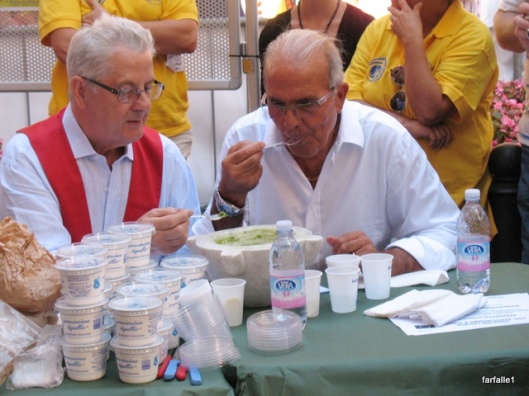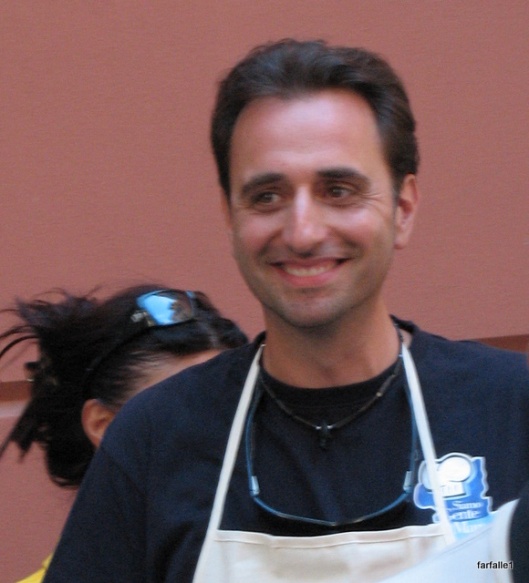Tags
Fred Plotkin, Giancarlo Dughera, Latte Tigullio, Marcello Ghizzo, Pesto, RapalloExpo, Recipes from Paradise, Roberto Ciccarelli
6 contestants, each with mortar and pestle; 7 ingredients; 20 minutes; and 2 judges: that’s all that was required for the 3rd annual Gara di Pesto al Mortaio which took place Saturday afternoon as part of RapalloExpo 2010.
This four-day event featured a street market with more stalls than usual, conferences on various aspects of food production (bees and honey!), entertainment, and my favorite: the pesto cook-off. It’s not really a cook-off, of course, because pesto isn’t cooked; so perhaps ‘competition’ would be a better word, though that hardly conveys the sense of excitement as a small crowed watched the very physical preparation of Liguria’s signature sauce.
Fred Plotkin, in his wonderful book Recipes from Paradise (Little, Brown and Company, 1997) gives 16 pesto recipes, including one for tourists, and one for people who are physically impaired and must use a food processor. (Impairment is the only excuse for using a processor, according to Mr. Plotkin, because the delicate perfumes and flavors of the ingredients will be compromised by the harsh treatment of the metal blades.)
No, mortar and pestle is the only way to make pesto. And there are only 7 ingredients in the classic Ligurian pesto (since Liguria is the home of pesto, it goes without saying that Ligurian pesto is the only one worthy of consideration). The 7 ingredients needed are coarse sea salt, basil leaves (preferably small), garlic, pinoli, Pecorino Romano cheese, Parmigiano-Reggiano cheese and olive oil. (Mr. Plotkin’s rendition of the classic dish can be found here.)
Chef Mario (pictured below), president of the Association of Chefs for the Genova region and Chef of Ristorante Da Mario in Rapallo was joined in the judging duties by a gentleman from Genova who is, if I understood correctly, somehow involved in the oversight of Pesto making in the region.
Pesto is made by putting a little bit of sea salt in the mortar, and carefully but enthusiastically adding the other ingredients and grinding it all into a thick paste. The finished product looks like this:
The contestants made only a small amount of pesto, enough for the judges to taste to reach their decision.
The first to finish was this lady, though sadly she did not win first place:
So who did win? Well, third place went to Marcello Ghizzo, center below:
and the second prize was awarded to Giancarlo Dughera:
The grand 1st place finisher was Roberto Ciccarelli:
What were the prizes? There was something that looked like a large gym bag, an apron, and various condiments from Latte Tugullio, the local company that generously sponsors many civic events. Oddly, included in the prizes were jars of… pesto!
The carton pictured above is a milk product called Prescinsêua (pronounced pray-zhun-sieu), also called Quagliata Genovese. It is a basic Ligurian ingredient made of fermented milk, not too different from clabbered cream or, perhaps, sour cream. Some people use Prescinsêua in their pesto-making.
It was a lovely event. Everyone from participants to audience to judges were good-humored. Finally, here are a couple of pictures of the audience, because what’s a Gara without a crowd?













How gratifying to hear from Fred Plotkin, and what a discerning blog reader he must be! I wish I could have been at the event to smell and taste the beautiful pestos and feel so lucky that we got to enjoy the delicious pesto that you made in my kitchen! I love the close-up photo of the pesto in the mortar, but the thing that truly impresses me is the beauty of the hand holding the pestle – hand model stand-in? The other strong impression I got was that if looks could kill, Marcello would be stone cold dead.
This was a wonderful report. Wish I had been there. I too miss Latte Tigullo and their products. My other favorite event is about to take place: on August 16 is the Sagra del Cane in San Rocco above Camogli. San Rocco is the patron saint of dogs and this event honors great canines from all over Italy. It is also described in Recipes from Paradise. More info too in “Italy for the Gourmet Traveler.” Ciao, Fred
Pecorino Romano – hmmm… yet another purchase for next visit!
It all looks and sounds absolutely yummy!
Pidge, I think it’s available in the States as well, though maybe not in a regular supermarket… research needed!
oh how i miss Latte Tigullio .. still my favorite in the world
They always seem to be sponsoring, helping, giving prizes. And sometimes they have great promotions in stores too – I once bought some eggs and was given mozarella as a prize. Seems like a great company to me.
What a lot of fun – and you get pesto as well!
Yum – yes! I foolishly had made it in the processor the week before. Have now learned the error of my ways and am appropriately repentant.
I had no idea there was such a gara! the perfume must be absolutely killingly wonderful.
Oh yes, I should have said – the air was sweet with it.
What a great article! It brought back memories…
Sue and Pat – it was delightful, mostly because it was just so low-key and done in fun. Plus the pesto looked yummy!
Fantastic, what a great event.